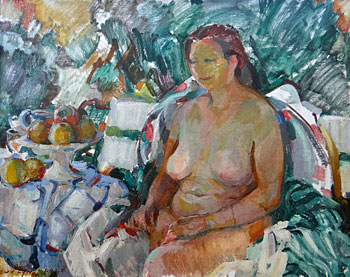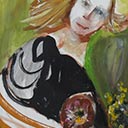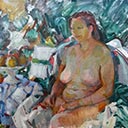Seated Nude, 1962
60 x 75 cm
PROVENANCE
Acquired directly from the artist, 1962
Estate of Sylvia Constance Ashton-Warner MBE
Evelyn Page is renowned as one of New Zealand's foremost colourists and for the independent conviction she maintained throughout her career thereby following her own creative path. Through her early lessons and experiences in Christchurch Page became steeped in the lessons of the British School. Her own use of high-keyed colour dates from the late 1920s, possibly influenced by the return to Christchurch in 1925 of the artist's friend Margaret Anderson after two years of travel full of enthusiasm for contemporary French and British painting. Then, by the 1960s she had also studied many of the key colourists of European Modernism, absorbing the colour lessons of Vuillard, Bonnard and Matisse, the compositional structures of Cézanne's figure paintings and the luscious painterly structure of form achieved by Matthew Smith.
However her responses to the mentors and possible influences of Modernism were wilfully independent. On the one hand she seemed impervious to the tendency of her peers to follow the innovative front lines of mid-century European Modernism; and on the other hand, even when she was embracing the discoveries of the Post-Impressionists, it was on her own terms, only responding to those aspects of their work that reinforced her own preoccupations with colour.
The decade of Seated Nude, 1962 was particularly rich for Evelyn Page, who was also in her sixties. Her children were grown; and she had created two environments that stimulated her creativity: the lime-edged orchard garden at Waikanae and the light-filled home in Hobson Street, Wellington. After more than four decades of working and painting she was finally receiving national recognition, for instance being included in the third Eight New Zealand Painters exhibition, toured by the Auckland City Art Gallery from October 1959. There was international regard too, when in 1962 the English art critic Sir Herbert Read and his wife came to dinner with Evelyn and Frederick Page at their Hobson Street home and he was impressed by one of the two nude paintings she made that year.
By the early 1960s her joy at being able to use a setting such as her garden at Waikanae as the setting for many outdoor studies, nudes and figure groups was palpable in the paintings themselves. Seated Nude, 1962 is one such painting. Serene; showing the artist's ability to absorb the structural lessons of Paul Cézanne and Matthew Smith without being a slave to either; and finding her way with a verdant and fleshy colour palette that is delicately haunted by French Post-Impressionism and redolent of the New Zealand outdoors at the same time. More than an art history lesson, Seated Nude 1962 communicates Page's joyful celebration of life. The painting was purchased by the artist's friend Sylvia Ashton-Warner.
Sylvia Ashton-Warner was born in Stratford, Taranaki in 1908. She was a novelist, autobiographer and educational pioneer. Two of her novels were listed in Time magazine's top ten books of the year. She won the New Zealand Book Award for Non-Fiction in 1980. In 1982 she was appointed a Member of the Order of the British Empire for services to education and literature. Her life story was adapted for the 1985 biographical film Sylvia, based on her work and writings. The Faculty of Education library at The University of Auckland where Ashton-Warner trained in the late 1920s, was named the Sylvia Ashton-Warner Library in 1987. The Ashton School in the Dominican Republic was founded in 1998 and was named in honour of Ashton-Warner, whose teaching methods inspired the school. Ashton-Warner died in Tauranga 1984.





